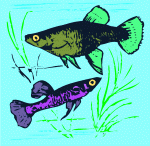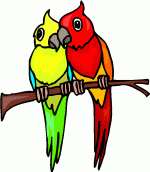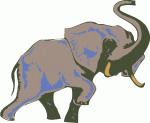In previous Japanese courses, you learned that います is used to express the existence of animate things (people, animal, insects, etc.) and あります for inanimate things (books, buildings, tree, etc.)
Ownership (to have, to own) is also expressed with います for people, animals, insects etc. For example, “I have a younger brother” will be わたしは おとうとが います。
Look at the pictures below and see who has the following items. You see the picture and the name of the person who has the animal. Pay close attention to how this is said in the column at the far right.
アリシア |
 さかな(魚)、にひき(二匹) |
アリシアは、さかなが にひき います。 (アリシアは、魚が、二匹 います。) |
ロバート |
 とり (鳥)、にわ(二羽) |
ロバートは、とりが にわいます。(ロバートは、鳥が、二羽 います。) |
| わたしたち |  ちょう(蝶)、にひき(二匹) |
わたしたちは、ちょうが にひき います。(私達は、蝶が 二匹 います。) |
わたし |

かえる(蛙) |
わたしは、かえるが います。(私は、蛙が います。) |
あなた |
 ぞう(象) |
あなたは、ぞうが います。(あなたは、象が います。) |
ともだち |
 ぞう、にとう (象、二頭) |
ともだちは、ぞうが にとう います。(友達は、象が 二頭 います。) |
![]() Counters
Counters
People are counted with ~にん(~人). Please be careful as one and two persons are irregular. Large animals such as elephant horses and cows are counted with~とう(~頭). Small animals such as cats and dogs, insects and fish are counted with ~ひき(~匹) and birds are counted with ~わ(~羽).
People |
Large Animals |
Small Animals, Insects, Fish |
Birds |
|
1 |
ひとり (一人) |
いっとう (一頭) |
いっぴき (一匹) |
いちわ (一羽) |
2 |
ふたり (二人) |
にとう (二頭) |
にひき (二匹) | にわ (二羽) |
3 |
さんにん (三人) |
さんとう (三頭) |
さんびき (三匹) |
さんわ、さんば (三羽) |
4 |
よにん (四人) |
よんとう (四頭) |
よんひき (四匹) |
よんわ (四羽) |
5 |
ごにん (五人) |
ごとう (五頭) |
ごひき (五匹) |
ごわ (五羽) |
6 |
ろくにん (六人) |
ろくとう (六頭) |
ろっぴき (六匹) |
ろくわ (六羽) |
7 |
ななにん (七人) |
ななとう (七頭) |
ななひき (七匹) |
ななわ (七羽) |
8 |
はちにん (八人) |
はっとう (八頭) |
はっぴき (八匹) |
はちわ (八羽) |
9 |
きゅうにん 九人) |
きゅうとう (九頭) |
きゅうひき (九匹) |
きゅうわ (九羽) |
10 |
じゅうにん (十人) |
じゅっとう (十頭) |
じゅっぴき (十匹) |
じゅうわ (十羽) |
How Many? |
なんにん (何人) |
なんとう (何頭) |
なんびき (何匹) |
なんわ (何羽) |
![]() Reading Practice
Reading Practice
Respond to the questions below. Click each sentence and the correct answer will appear. If you are uncertain about direct objects in English, you will want to be in communication with your teacher.
Basically, a direct object pronoun answers the question "who?" or "what?" about the object. Examples: I speak Japanese. I speak WHAT? Japanese. "Japanese" answers the question "what", making it the direct object. Look at the others in the above chart. Do you practice golf? Do you practice WHAT? Golf. Golf is the direct object. In English, we answer the above question saying, “yes, I practice it” or “no, I don’t practice it.” A word (for example, a direct object in an answer) tends to be omitted when it is understood from the context.
| にほんごを はなしますか。(日本語を 話しますか。) | はい、はなします。(はい、話します。) |
| ゴルフを れんしゅうしますか。(ゴルフを 練習しますか。) | いいえ、れんしゅうしません。(いいえ、練習しません。) |
| きんようびに おばあさんのうちに いきますか。(金曜日に 御祖母さんの家に 行きますか。) | はい、きんようびに いきます。 (はい、金曜日に 行きます。) |
| どようびに テレビをみますか。(土曜日に テレビを見ますか。) | はい、どようびに みます。(はい、土曜日に 見ます。) |
| きってを あつめますか。(切手を集めますか。) | いいえ、あつめません。 (いいえ、集めません。) |
| ピアノを ひきますか。(ピアノを弾きますか。) | いいえ、ひきません。(いいえ、弾きません。) |
![]() Additional Practice
Additional Practice
Practice direct objects in this activity. Rewrite the sentences below by replacing nouns with direct object pronouns.
| わたしは、えいごとスペインごを はなします。(私は、スペイン語と英語を 話します。) | わたしは、それらを はなします。(私は、それらを 話します。) |
| わたしは、ギターとピアノを ひきます。(私は、ギターとピアノを 弾きます。) | わたしは、それらを ひきます。(私は、それらを 弾きます。) |
| たしは、おかねを あつめます。(私は、お金を 集めます。). | わたしは、それを あつめます。(私は、それを 集めます。) |
| ちちは、テレビをみます。(父は、テレビを見ます。) | ちちは、それを みます。(父は、それを 見ます。) |
| あには、おんがくを ききます。(兄は、音楽を聞きます。) | あには、それくを ききます。(兄は、それを 聞きます。) |
| わたしたちは、フットボールとやきゅうを れんしゅうします。(私達は、フットボールと野球を練習します。) | わたしたちは、それらを れんしゅうします。(私達は、それらを 練習します。) |
![]() Graded Assignments
Graded Assignments
Please return to the Section 1 Tasks & Assignments folder to complete the graded assignments for Section 1, Part D.

